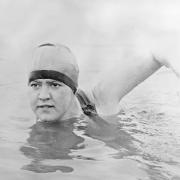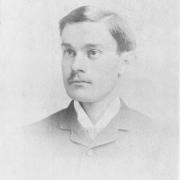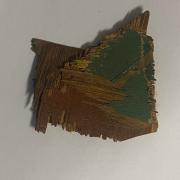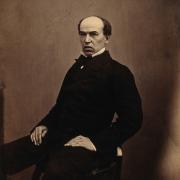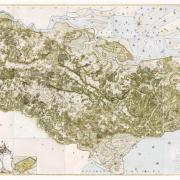Only in Kent could we follow January's article on General Woolfe, the foremost soldier of the 18th century, with a look this month at the life of a star of the Carry On movies of two centuries later. Yes, it's now time for the voluptuously proportioned Hattie Jacques (1922-80), a screen, stage and radio actress, and talented comedienne, to step into the spotlight.
There’s a blue plaque on Hattie’s birthplace in Sandgate, near Folkestone, on the Kentish Riviera. It’s to be found adorning Strand House, at 125 High Street. In the style of Hattie’s most popular character, her formidable Matron, it doesn’t waste words: ‘Hattie Jacques, English comedy actress, 1922-1980, born here’. She was actually born Josephine Edwina Jaques on 7th February 1922, the youngest daughter of serviceman Robin Rochester Jaques (1897-1923). I know, what a wonderful middle name. It’s both very Charlotte Brontë and very Kent. Sadly the dates tell us Hattie never really knew her Dad who perished in a flying accident when Hattie was just a tot. Her Mum was nurse Mary Jaques (née Thorn). She certainly wasn’t born into a family that trod the boards, although her Mum had appeared in panto. It was her love of theatre that enthused Hattie, who trained originally as a hairdresser.

Beginning her career during WW2, starting in music hall in 1944, Hattie first came to prominence on the radio, appearing with Tommy Handley on ‘It’s That Man Again’, with ventriloquist Peter Brough on ‘Educating Archie’ and later with comedic actor Tony Hancock in ‘Hancock’s Half Hour’, which started as a radio comedy before transferring successfully to TV. Having appeared on stage, her screen debut came in 1946 in a minor role, uncredited, in ‘Green for Danger’. 'Jaques' became 'Jacques' as her career launched.
She’s most associated with the long-running franchise of ‘Carry On’ films, appearing in no fewer than 14 of these between 1958 and 1974, her most popular character being ‘Matron’, including in ‘Carry on Matron’, a tribute if ever there was to the popularity of the character and the actress. The films were laced with innuendo and the exchange between ‘Dr. Tinkle’ (Kenneth Williams) and ‘Matron’ (our Hattie) in ‘Carry on Doctor’ (1967) is typical of the genre:
Tinkle: ‘You may not realise it but I was once a weak man’.
Matron: ‘Once a week is enough for any man’.
I would have loved to have had the opportunity to write slapstick like that.
Jacques did well out of ‘Matron’, appearing as this redoubtable character in five different films and establishing not only the character in the public’s consciousness but also Hattie herself as an archetypal figure of that period. A certain amount of nostalgia also applies to Hattie’s most famed character as people look back, fondly perhaps, to a time when the NHS was more cottage hospital than monolith and the matron was a symbol of female empowerment. In a case of art imitating life Hattie had actually been a nurse with the Voluntary Aid Detachment (VAD) during WW2. She also worked as a welder during the war.

Apparently she was paid £2,000 for her role in Carry on Dick, the 26th film in the series, which was based extremely loosely on the exploits of highwayman Dick Turpin and starred that Carry On stalwart Sid James as Dick. That equates to about £17,000 in today’s money, which is handy but certainly not a fortune.
A long professional partnership with Eric Sykes straddled her Carry On era, in which Hattie co-starred in his sitcoms Sykes and a … (1960-65) and Sykes (1972-79), in which she played her co-star’s sister. She also appeared in two Norman Wisdom films. ‘The Square Peg’ and ‘Follow a Star’.
Hattie was married to another sitcom legend, John Le Mesurier (1912-83), who played Sgt. Wilson in the Dad’s Army series (1968-77). They were married in 1949, had a house together in Margate. Divorce came in 1965, the end game of a five-year affair she’d had. Hattie’s private life was an anguished mess and yet, as an actress, she showed steely resolve to ‘keep calm and carry on’ (see what we did there). This was never better exemplified, perhaps, than when she was a subject of TV's This Is Your Life in 1963, having been ambushed by Eamonn Andrews. It must have been a testing occasion for Hattie to have her life pored over at the very time when her marriage was crumbling. The story of Hattie moving a Cockney car dealer in, with John taking up residence in the spare room, is true enough and yet could be taken straight from one of those ‘Carry On’ scripts.
The final TV appearance for Hattie came in an advert for ASDA (1980). She died a few months later of a heart attack. Her comedy was of a larger-than-life persuasion although this statement shouldn’t disguise the fact she could also be highly versatile, appearing in Dickens adaptations when she was younger, and that she’s regarded as a key figure in post-war popular culture. Physically she was larger-than-life too, of course, 5 feet 6 inches but with weight that accumulated to 20-odd stone, making it hard to believe she had once been a ballet dancer. The word from fellow actors and friends was she didn’t like being that size, that she took quite a few knocks because of it, and perhaps didn’t get all the breaks she deserved as an actress as the male-dominated scene of the time insisted on typecasting her. Her life too was larger-than-life; she liked nothing better than a raucous party.
Her nicknames included ‘Mother Superior’ and the rather more affectionate ‘Hat’. Behind the actress though was a very human being, who despite her own travails was the kind of generous soul who would adopt a naval squadron or visit a little girl in hospital, gifting her a bracelet.






